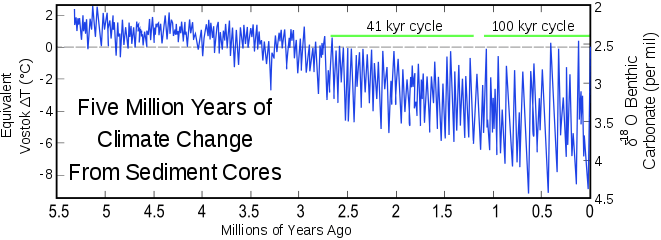Don Glaciation
The Don Glaciation, also known as the Donian Glaciation and the Donian Stage, was the major glaciation of the East European Plain, 0.5–0.8 million years ago, during the Cromerian Stage of the Middle Pleistocene.[1] It is correlated to Marine Isotope Stage 16 (MIS 16),[2] approximately 650,000 years ago, which globally contained one of the largest glacial volumes of the Quaternary.[3]

Don Glaciation
The Don Glaciation shows evidence of the most extensive ice sheet on the East European Plain, extending into the drainage basin of the middle and lower Don River in Russia, reaching 50 degrees north latitude. This glaciation occurred before the Muchkap interglacial and the Oka and Dnieper glaciations of Eastern Europe.[4][5][6]
Marine Isotope Stage 16
MIS 16 is a major glacial stage identified through measurements of oxygene isotopes in deep sea core samples (marine isotope stage) of Cromerian age, approximately 676-621 ka ago.[7] In terms of global ice volume, it ranks as one of the two most extreme glaciations of the Quaternary, on par with MIS 12.[3][2] However, in terms of sea water temperatures it is a much more modest glaciation, of similar climate intensity to the neighbouring Cromerian glaciations MIS 14 and MIS 18.[3] The atmospheric concentration of CO
2 was below 180 ppm for 3 ka during MIS 16, the lowest of the last eight glacial cycles.[2]
Correlations
Don and MIS 16 are usually correlated to each other. This is based on assumption that the most widespread evidence for glaciation in the Cromerian ought to be associated with the largest glaciation on the global scene. However, the time resolution of current age determinations is insufficient for a clear distinction between MIS 14, MIS 16 and MIS 18.[2][6][1] It is unclear why the major glaciation of MIS 16 has left very little evidence in the geological records of Western Europe.[6] MIS 16 is believed to correspond to Pre-Illinoian D in North America.[8]
See also
References
- Cambridge Quaternary Palaeoenvironments Group: Don Glaciation
- Philip D. Hughes and Philip L. Gibbard: Global glacier dynamics during 100 ka Pleistocene glacial cycles, Quaternary research, Volume 90, Issue 1, pp 222-243.
- N. Lang and E.W. Wolff (2011): Interglacial and glacial variability from the last 800 ka in marine, ice and terrestrial archives, Climate of the Past, 7, 361-380.
- AvJ. Ehlers and P.L. Gibbard: Quaternary Glaciations - Extent and Chronology: Part I: Europe, Don glaciation, pp 343-344.
- A.A. Velichko and H.E. Wright: Cenozoic Climatic and Environmental Changes in Russia, Don glaciation, p 50.
- Böse et al. (2012), Quaternary Glaciations of Northern Europe, Quaternary Science Reviews 44, 1-25.
- Lisiecki, Lorraine E.; Raymo, Maureen E. (2005). "A Pliocene-Pleistocene stack of 57 globally distributed benthic δ18O records". Paleoceanography. 20 (1): n/a. Bibcode:2005PalOc..20.1003L. doi:10.1029/2004PA001071.
- J. Ehlers, P.L. Gibbard, P.D. Hughes: Quaternary Glaciations - Extent and Chronology: A Closer Look, Discussion of the dating of the age of glacial limits, pp 523-524.